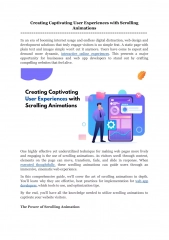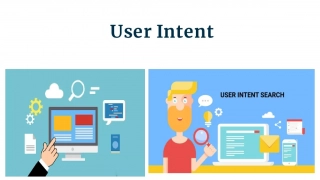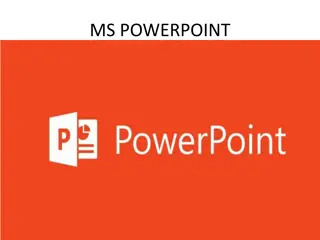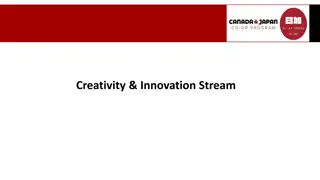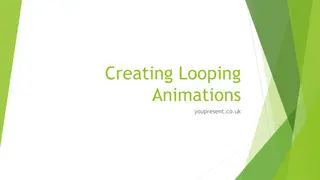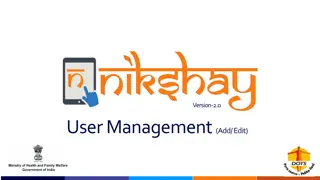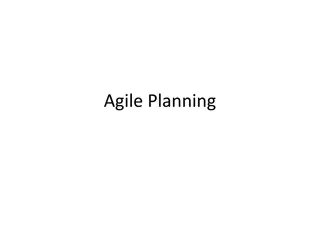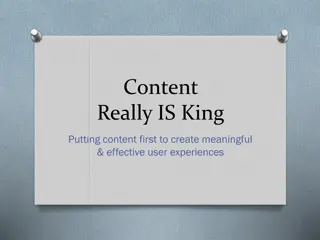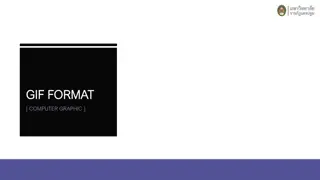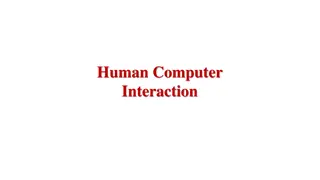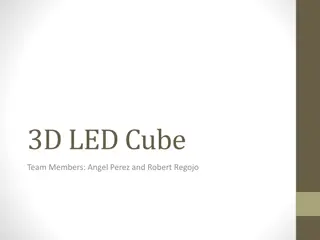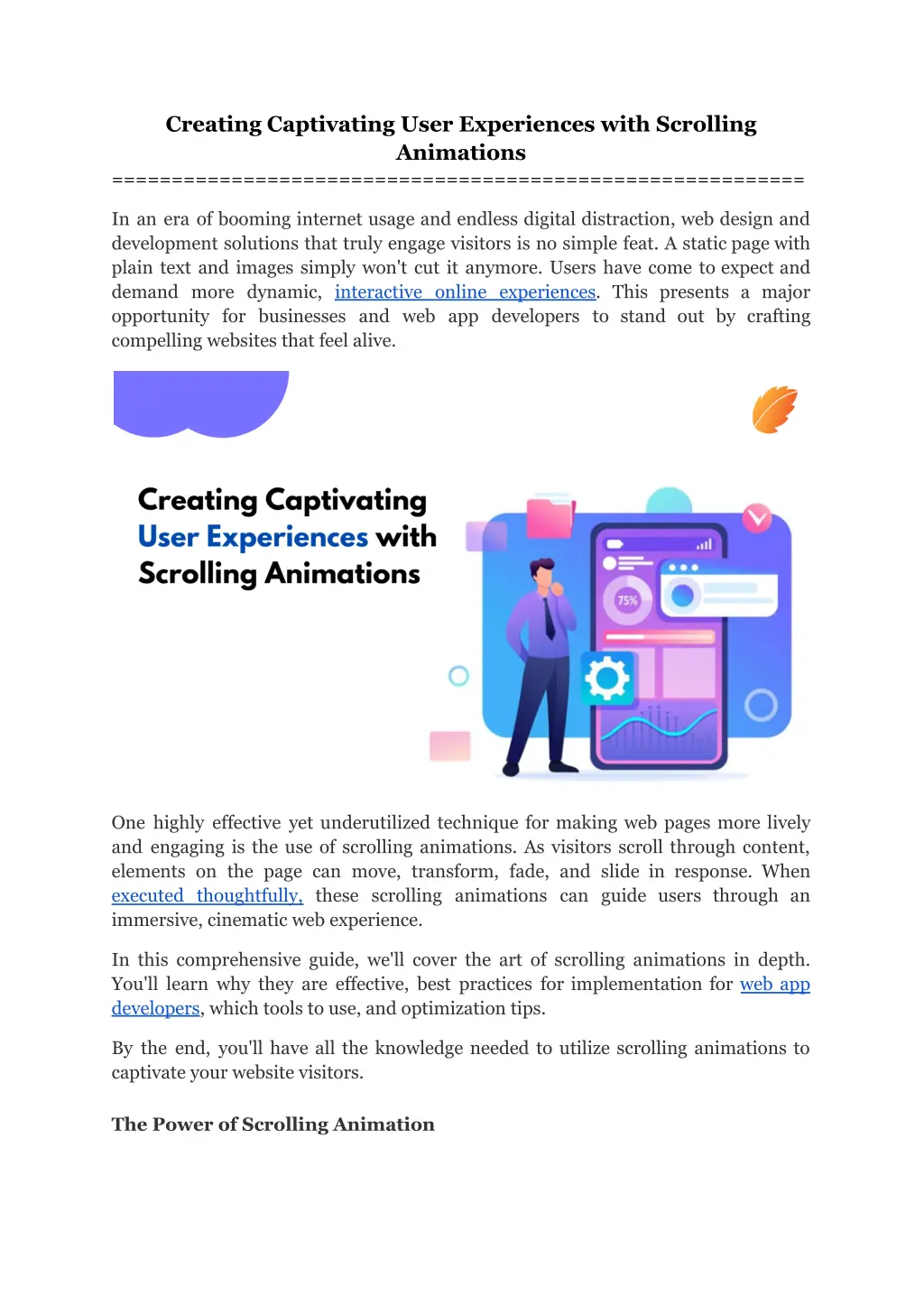
Creating Captivating User Experiences with Scrolling Animations
Learn how to captivate users and boost engagement on websites through purpose-driven scrolling animations. This comprehensive guide covers why subtle scroll-based motions are effective, implementing best practices, choosing technical approaches, creative examples, optimization tips, and designing responsive, animated interactions accessible to all. Take web development services to the next level by strategically choreographing key page elements to move, transform, fade, and slide into view as visitors scroll.n
Download Presentation

Please find below an Image/Link to download the presentation.
The content on the website is provided AS IS for your information and personal use only. It may not be sold, licensed, or shared on other websites without obtaining consent from the author. If you encounter any issues during the download, it is possible that the publisher has removed the file from their server.
You are allowed to download the files provided on this website for personal or commercial use, subject to the condition that they are used lawfully. All files are the property of their respective owners.
The content on the website is provided AS IS for your information and personal use only. It may not be sold, licensed, or shared on other websites without obtaining consent from the author.
E N D
Presentation Transcript
Creating Captivating User Experiences with Scrolling Animations ========================================================== In an era of booming internet usage and endless digital distraction, web design and development solutions that truly engage visitors is no simple feat. A static page with plain text and images simply won't cut it anymore. Users have come to expect and demand more dynamic, interactive online experiences. This presents a major opportunity for businesses and web app developers to stand out by crafting compelling websites that feel alive. One highly effective yet underutilized technique for making web pages more lively and engaging is the use of scrolling animations. As visitors scroll through content, elements on the page can move, transform, fade, and slide in response. When executed thoughtfully, these scrolling animations can guide users through an immersive, cinematic web experience. In this comprehensive guide, we'll cover the art of scrolling animations in depth. You'll learn why they are effective, best practices for implementation for web app developers, which tools to use, and optimization tips. By the end, you'll have all the knowledge needed to utilize scrolling animations to captivate your website visitors. The Power of Scrolling Animation
What exactly makes thoughtfully crafted scrolling animations such a powerful way to engage visitors? There are several key reasons: Directing the User's Attention As humans, we are wired to pay attention to motion. This instinct is a matter of evolutionary survival. In web design and development, subtle animated motions guide the user's eyes across the page to areas any website development company wants them to focus on. Key calls-to-action, impactful images, and other important page elements can fade or slide into view at just the right moment during the scroll to emphasize them. When visitors immediately focus on your intended key message, engagement improves. Developing an Intuitive Narrative Scrolling animations allow you to carefully reveal information and creative assets in a logical progression as users scroll down the page. This develops an intuitive narrative that builds on each new reveal. Visitors understand precisely where to look and in which order because the sequence of animations leads them there fluidly. Storytelling principles and human cognitive patterns inform the sequencing and choreography. Delivering Surprise and Delight Thoughtful animations timed with scrolling can elicit positive emotional responses like surprise, intrigue, and delight. These emotions captivate visitors in the moment to keep them engaged. For example, scrolling could trigger an illustration to come alive through charming character animation. Such small, unexpected delights make the experience more memorable and enjoyable.
Crafting Immersive Experiences Scrolling animations can help create a truly immersive user experience where visitors feel transported into a digital world. The right animations respond and react to the user's scrolling in a way that makes the content feel more tangible and real. This level of immersive experience sparks deeper emotional investment and engagement from the user. Dynamic Brand Differentiation Finally, creatively executed scrolling animations allow brands to provide web development services with a truly distinct, recognizable aesthetic. The animations bring a brand's image to life digitally for a differentiated user experience. Like innovative UI/UX design, scrolling animation techniques can become signature brand elements when consistently applied. This helps foster brand loyalty and recognition. As you can see, when leveraged effectively, scrolling animations check all the boxes for boosting user engagement. They guide visitor attention, craft cohesive narratives, spark emotional responses, increase immersion, and help web app developers stand out.
Now, let's explore some best practices for web design and development animation implementation. Implementing Scrolling Animation Effectively Here are key guidelines to follow when adding scrolling animations to your web design and development: Begin with Purpose and Strategy Before determining which animations to implement, step back and consider the broader strategy and purpose behind them. What exactly do you want the animations to achieve for the overall user experience? How will they enhance the narrative? Make sure each animation ties back to well-defined UX goals rather than just adding motion for the sake of it. Embrace Subtlety The most effective scrolling animations in web design and development are subtle and understated. Big, flashy animations tend to feel gimmicky and distract from content. Remember, the animations are there to enhance the content, not overpower it. Small hints of motion in the corner of the user's eye work best to pique interest and gently guide visitors without disruption. While scrolling animations can make web design and development more engaging, it's crucial to ensure they do not come at the expense of usability, accessibility, or most importantly, the core function of the website. The primary goal should remain to convey information or provide a service to users effectively. No matter how delightful, animations that hinder achieving that key objective add entertainment value at the cost of overall user experience. Striking the right balance means respecting fundamental web design and development principles. Animations should direct focus, not overwhelm. They should adapt seamlessly to any device or browsing configuration. Content hierarchies
and navigation should stay clear. Every effect should map back to purposeful UX and business goals. Keeping these priorities in check allows scrolling animation to enrich digital experiences rather than detract from core website functionality. Design Responsively Ensure any scrolling animations and effects work seamlessly on all device sizes, especially mobile. Mobile optimization is crucial, so preview the animations on real mobile devices during development. Also, design the animations to degrade gracefully, still providing value even if a user has animations disabled. Mind the Performance Impact Scrolling animations require work from the browser to trigger based on scroll position and calculate movement. As such, take care to not overload a page with too many performance-intensive animations that might slow things down. Find the optimal balance between visual appeal and fast load times. To efficiently integrate animations without compromising speed: - Animate properties like opacity and transform rather than layout-intensive properties like width/height - Use the CSS will-change property to signal what properties will be animated, allowing the browser to optimize rendering - Leverage hardware acceleration to offload intensive calculations to the GPU - Group smaller animated elements into fewer, larger containers when possible Careful optimization ensures animations delight users without frustrating them with laggy pages. Focus effects on key focal points rather than overusing motion across the entire page. A selective, purposeful implementation prioritizing subtlety reduces performance concerns.
Accommodate Accessibility Follow web accessibility best practices when crafting scroll animations. For example, allow sufficient time for screen readers to first announce content before an animation triggers to unveil it. Also, provide ways to pause or turn off animations for those sensitive to motion. More specific techniques include: - Use the prefers-reduced-motion CSS media query to honor system preferences and avoid animating for users who have indicated sensitivity - Add aria-live regions to update assistive tech users when content changes, ensuring screen readers announce animations - Ensure content and navigation remain fully accessible and usable with animations disabled - Avoid relying solely on animations to convey meaning, include redundant text/color affordances - Test animations at reduced motion levels to confirm focal content is still scannable and comprehensible Careful development following WCAG standards keeps animations an enhancement rather than a hinderance. With forethought devices/preferences, scroll animations can be part of an inclusive, usable experience for all users. and testing across assistive Maintain Cohesive Branding While each page may have unique animations, try to design them with consistent branding and aesthetics. This strengthens brand recognition. For example, always use the same tastefully muted color palette and smooth, subtle motion styles. Consistency evokes familiarity. Choosing the Right Technical Approach You have a few options for enabling animations that trigger based on scroll progress. The best approach depends on the project s needs and your team s skills. CSS Animations For simple animations like fade-ins, CSS transitions, and keyframe animations offer a relatively easy path. Any web development company can animate page elements by defining CSS rules that apply styles like opacity and transform based on pseudo-classes like: hover and active. CSS also provides options to delay or time the animations.
Benefits of CSS animations: - No need for JavaScript, less overall code - Native web platform features, well-supported - Lightweight performance Downsides: - Less flexibility and customization control - Can't react to scroll position - Complex effects difficult JavaScript Scroll Libraries For more advanced scroll-driven animations in web design and development, dedicated JavaScript libraries like GreenSock ScrollTrigger, ScrollMagic, and AOS (Animate on Scroll) are extremely helpful. They provide options to anchor animations to certain points in the scroll, allowing you to trigger them precisely. This unlocks capabilities for web app developers like choreographing sequences of animations that respond to scrolling through sections. Benefits of JS scroll libraries:
- Support complex sequenced animations based on scroll position - Animate beyond just CSS, like Canvas, SVG, etc - More control over parameters and customization Downsides: - Additional code/libraries required - Performance considerations of JS - Advanced development skills needed Full Page Scrolling Frameworks For truly immersive and interactive full-page scrolling experiences, with anchor points between sections, dedicated frameworks like fullpage.js are helpful. This enables scrolling between screen-sized sections instead of simply scrolling down one long page. The transitions between sections can contain advanced animations and parallax effects. Benefits of full-page frameworks: - Build a multi-screen scrolling experience - Support extremely advanced/interactive effects - Scrolling capabilities go beyond the main vertical Downsides: - Overkill for simple needs - Learning curve and development overhead
- Performance optimization is crucial For most websites, a hybrid approach utilizing both CSS and JavaScript scrolling libraries hits the sweet spot between capability and complexity. When implementing animations, some key pitfalls to avoid include causing excessive layout recalculations and animating many individual elements separately using JavaScript loops. Advanced techniques involve utilizing features like the Intersection Observer API to trigger anims as elements come into view. You can also leverage CSS custom properties to enable scripting control of animation attributes. The optimal technical solution often involves a hybrid mix of CSS, JavaScript, and libraries - applying the right capabilities to create performant, cohesive effects. By combining approaches judiciously, web app developers can unlock the full creative potential of scroll-based animation. Creative Examples to Inspire Still not sure how to effectively use scrolling animations? Here are some great examples to spark ideas: Stripe's homepage animates individual page sections on a scroll to transition between them smoothly. HubSpot's website attractively animates headers, images, and cards on a scroll to direct attention. Trello's scrolling animations and transitions make exploring their extensive homepage effortless. Mailchimp creatively animates individual characters of headings for fun reveal effects. Don't be afraid to experiment- done thoughtfully, scrolling animations can take your web pages from static to dynamic. Focus on enhancing user experience and your
brand impression. With strategic implementation and testing, scrolling animations can make your website truly engaging. Conclusion When applied strategically with care to accessibility and UX principles, scrolling animations in web design and development can captivate users and take websites to the next level. The ability to guide user attention, reveal narratives, spark delight, and increase immersion is powerful. However, restraint is still needed to avoid the overuse of animations at the expense of performance and focus. As with all emerging web design trends, the flashy effects should enhance, not overwhelm, core content and functionality. There are also inherent challenges to address: Performant scrolling animation requires optimization expertise. Complex animations can impact page load times if not efficiently coded. Excessive motion risks distracting users rather than directing focus. Animation should be subtle and purposeful. Accessibility best practices need incorporation so those sensitive to motion can still use the site comfortably. Scrolling animations pose challenges on mobile devices with less processing power. Responsiveness and optimization are key. Over-reliance on trendy animations could potentially date websites designed today in the future. A balance with timeless minimalism is ideal. Looking ahead, advances in web design and development capabilities will enable even more immersive animations while best practices will continue emphasizing subtlety and focus. Striking the optimal balance results in delightful user experiences that aid brand goals. The most effective implementations will likely involve hybrid approaches that leverage HTML, CSS, a bit of JavaScript, and scrolling libraries judiciously. Animation will be treated as an enhancement rather than the sole basis of engagement. Companies like Consagous Technologies stay ahead of web design and development best practices to craft captivating yet balanced websites. Our award-winning web app developers expertly utilize scrolling animations alongside timeless design principles to create experiences that attract and retain. By consulting closely with clients to understand brands and goals, we incorporate trends like animation strategically to maximize results. See how a leading web design and development company, Consagous Technologies' balanced utilization of scrolling animations and other engagement tactics brings websites to life. Contact us for a consultation today on crafting captivating and effective sites!

